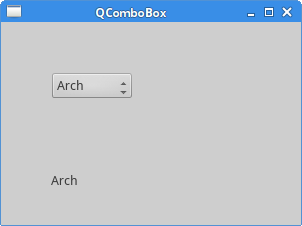PyQt6 组件 (二)
本章继续介绍 PyQt6 组件,包含了 QPixmap,QLineEdit,QSplitter 和 QComboBox。
PyQt6 QPixmap
QPixmap 是用于处理图像的小组件,为显示图像进行了优化。下面是使用 QPixmap 渲染图像的示例。
#!/usr/bin/python
# file: pixmap.py
"""
ZetCode PyQt6 tutorial
In this example, we display an image
on the window.
Author: Jan Bodnar
Website: zetcode.com
"""
from PyQt6.QtWidgets import (QWidget, QHBoxLayout,
QLabel, QApplication)
from PyQt6.QtGui import QPixmap
import sys
class Example(QWidget):
def __init__(self):
super().__init__()
self.initUI()
def initUI(self):
hbox = QHBoxLayout(self)
pixmap = QPixmap('sid.jpg')
lbl = QLabel(self)
lbl.setPixmap(pixmap)
hbox.addWidget(lbl)
self.setLayout(hbox)
self.move(300, 200)
self.setWindowTitle('Sid')
self.show()
def main():
app = QApplication(sys.argv)
ex = Example()
sys.exit(app.exec())
if __name__ == '__main__':
main()在窗口里展示了一个图片。
pixmap = QPixmap('sid.jpg')用文件名作为参数创建一个 QPixmap 对象。
lbl = QLabel(self)
lbl.setPixmap(pixmap)然后把 pixmap 放到 QLabel 组件里。
PyQt6 QLineEdit
QLineEdit 是一个可以输入单行文本的组件,它有撤消和重做、剪切和粘贴以及拖放功能。
#!/usr/bin/python
# file: line_edit.py
"""
ZetCode PyQt6 tutorial
This example shows text which
is entered in a QLineEdit
in a QLabel widget.
Author: Jan Bodnar
Website: zetcode.com
"""
import sys
from PyQt6.QtWidgets import (QWidget, QLabel,
QLineEdit, QApplication)
class Example(QWidget):
def __init__(self):
super().__init__()
self.initUI()
def initUI(self):
self.lbl = QLabel(self)
qle = QLineEdit(self)
qle.move(60, 100)
self.lbl.move(60, 40)
qle.textChanged[str].connect(self.onChanged)
self.setGeometry(300, 300, 350, 250)
self.setWindowTitle('QLineEdit')
self.show()
def onChanged(self, text):
self.lbl.setText(text)
self.lbl.adjustSize()
def main():
app = QApplication(sys.argv)
ex = Example()
sys.exit(app.exec())
if __name__ == '__main__':
main()本例中有一个 QLineEdit 组件和一个标签,在编辑器里输入的文本会立即显示在标签里。
qle = QLineEdit(self)创建一个 QLineEdit 组件。
qle.textChanged[str].connect(self.onChanged)如果编辑器的文本发生了变化,就调用 onChanged 方法。
def onChanged(self, text):
self.lbl.setText(text)
self.lbl.adjustSize()在 onChanged 里,把输入的文本设置到标签组件里,同时使用 adjustSize 方法调整文字显示。

图示:QLineEdit
PyQt6 QSplitter
QSplitter 允许用户通过拖动子部件之间的边界来控制子部件的大小。下面是被两个分割条分开的三个 QFrame 组件的示例。
#!/usr/bin/python
# file: splitter.py
"""
ZetCode PyQt6 tutorial
This example shows
how to use QSplitter widget.
Author: Jan Bodnar
Website: zetcode.com
"""
import sys
from PyQt6.QtCore import Qt
from PyQt6.QtWidgets import (QWidget, QHBoxLayout, QFrame,
QSplitter, QApplication)
class Example(QWidget):
def __init__(self):
super().__init__()
self.initUI()
def initUI(self):
hbox = QHBoxLayout(self)
topleft = QFrame(self)
topleft.setFrameShape(QFrame.Shape.StyledPanel)
topright = QFrame(self)
topright.setFrameShape(QFrame.Shape.StyledPanel)
bottom = QFrame(self)
bottom.setFrameShape(QFrame.Shape.StyledPanel)
splitter1 = QSplitter(Qt.Orientation.Horizontal)
splitter1.addWidget(topleft)
splitter1.addWidget(topright)
splitter2 = QSplitter(Qt.Orientation.Vertical)
splitter2.addWidget(splitter1)
splitter2.addWidget(bottom)
hbox.addWidget(splitter2)
self.setLayout(hbox)
self.setGeometry(300, 300, 450, 400)
self.setWindowTitle('QSplitter')
self.show()
def main():
app = QApplication(sys.argv)
ex = Example()
sys.exit(app.exec())
if __name__ == '__main__':
main()这里有三个 QFrame 组件和连个 QSplitter 组件,注意,在某些主题里,分割条可能不容易看到。
topleft = QFrame(self)
topleft.setFrameShape(QFrame.Shape.StyledPanel)给框架组件设置一些样式,这样更容易看清楚边界。
splitter1 = QSplitter(Qt.Orientation.Horizontal)
splitter1.addWidget(topleft)
splitter1.addWidget(topright)创建一个有俩框架组件的 QSplitter 组件。
splitter2 = QSplitter(Qt.Orientation.Vertical)
splitter2.addWidget(splitter1)再添加一个分割条和一个框架组件。
图示:分割条组件
PyQt6 QComboBox
QComboBox 是下拉选框组件,能让用户在一系列选项中进行选择。
#!/usr/bin/python
# file: combobox.py
"""
ZetCode PyQt6 tutorial
This example shows how to use
a QComboBox widget.
Author: Jan Bodnar
Website: zetcode.com
"""
import sys
from PyQt6.QtWidgets import (QWidget, QLabel,
QComboBox, QApplication)
class Example(QWidget):
def __init__(self):
super().__init__()
self.initUI()
def initUI(self):
self.lbl = QLabel('Ubuntu', self)
combo = QComboBox(self)
combo.addItem('Ubuntu')
combo.addItem('Mandriva')
combo.addItem('Fedora')
combo.addItem('Arch')
combo.addItem('Gentoo')
combo.move(50, 50)
self.lbl.move(50, 150)
combo.textActivated[str].connect(self.onActivated)
self.setGeometry(300, 300, 450, 400)
self.setWindowTitle('QComboBox')
self.show()
def onActivated(self, text):
self.lbl.setText(text)
self.lbl.adjustSize()
def main():
app = QApplication(sys.argv)
ex = Example()
sys.exit(app.exec())
if __name__ == '__main__':
main()示例中有一个 QComboBox 和一个 QLabel。下拉选框有一个包含五个选项的列表,是 Linux 发行版的名称。标签组件显示组合框中选择的选项。
combo = QComboBox(self)
combo.addItem('Ubuntu')
combo.addItem('Mandriva')
combo.addItem('Fedora')
combo.addItem('Arch')
combo.addItem('Gentoo')创建有五个选项的 QComboBox 组件。
combo.textActivated[str].connect(self.onActivated)如果选择了一个选项,就调用 onActivated 方法。
def onActivated(self, text):
self.lbl.setText(text)
self.lbl.adjustSize()在这个方法里,设置选中的文本到标签组件里,然后调整标签组件大小。

图示:QComboBox
